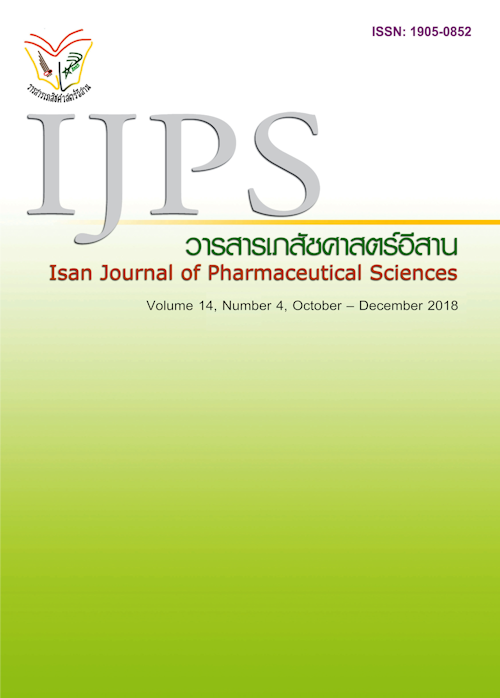Financial Burdens on Patients with End Stage Renal Disease Receiving Renal Replacement Therapy
Main Article Content
Abstract
Renal replacement therapy in patients with end stage renal disease (ESRD) using hemodialysis (HD) and peritoneal dialysis (PD) is high cost care. Renal replacement therapy is covered by all three public insurance schemes, namely Universal Coverage Scheme, Social Security Scheme, and Civil Servant Medical Benefit Scheme to increase access to care. However, out of pocket payment by patients is required for several items that are not included in the benefit package. This study aimed to assess financial burdens on patients who received HD or PD. Methods: Descriptive study design was used. Structured interview questionnaire was used for data collection in two tertiary care hospitals during April 2017. Study samples were patients with ESRD who received HD or PD for at least one year, receiving care continuously at the study hospitals, able to communicate, and willing to participate in the study. The structured interview questionnaire used in this study was approved by five experts in field. Descriptive statistics were used in data analysis. Results: Eighty six patients were included in this study, 42 of them were patients receiving HD and 46 of them were patients receiving PD. Patients receiving HD had more elderly with aged ≥ 65 years (HD 47.6%, PD 19.6%), urban living (HD 59.5%, PD 19.6%), higher education (secondary school HD 57.6%, PD 23.9%), greater proportion of patients in Civil Servant Benefit scheme (HD 57.2%, PD 4.4%), and higher percent of patients who had income > 5000 Baht per month (HD 38.1%, PD 15.2%). More than 60% of patients receiving HD or PD had no saving money. Patients receiving PD had more financial problems, and household debt while they paid out of pocket (OOP) for ESRD and complications less than those receiving HD (median OOP 1,000 Baht/month in PD and 4,000 Baht/month in HD). Financial burdens occurred in 65% of those receiving PD and 45% of those receiving HD. Among patients receiving HD, 21% of them coped with financial burdens by borrowing money and 12% of them selling their assets. Financial burdens were more severe in patients receiving PD and leading to borrowing money and selling their assets in 52% and 26% of patients, respectively. Greater financial burdens were found in patients with no income. Approximately 15% of HD and PD patients required informal caregivers in their daily life. Conclusion: PD patients who had no income, having financial problems and household debt were the most vulnerable group to face with financial burdens from ESRD and related complications.
Article Details
In the case that some parts are used by others The author must Confirm that obtaining permission to use some of the original authors. And must attach evidence That the permission has been included
References
Chuasuwan A, Praditpornsilpa K. editor. Thailand renal replacement therapy year. 2014.
Department of Health, Ministry of Health. Situation of aging people in Thailand, trend, characteristics and problems. [Online]. [cited 2018 Jan 3]. Available from: http://hp.anamai.moph.go.th/soongwai/statics/about/soongwai/topic004.php
Limwattananon S, Kongsawatt S, Pannarunothai S. Screening for poor people using household information. Journal of Health Science 2005; 14(2): 275-286.
Limwattananon S, Tangcharoensathien V, Prakongsai P. Catastrophic and poverty impacts of health payments: results from national household surveys in Thailand. Bull World Health Organ 2007; 85(8): 600-606.
McIntyle D, Thiede M, Dahlgren G, Whitehead M. What are the economic consequences for households of illness and of paying for health care in low- and middle-income country contexts? Soc Sci & Med 2006; 62: 858-65.
National Health Security Office. Manual of Administrative Criterion of National Health Security Fund Office: Chronic renal disease. 2015.
Patchanee K, Apinyanon J. Cetthkrikul N, Lertiendumrong J. Prakongsai P. Budget impact analysis of providing free for hemodialysis among new case of end stage renal disease. International Health Policy Program. 2001
Prakongsai P, Palmer N, Uay-trakul P,Tangcharoensathien V, Mills A. The implication of benefit package design: The impact on poor Thai households of excluding renal replacement therapy. J Int Dev 2009; 21: 291-308.
Riewpaiboon A. Standard Cost Lists for Health Technology Assessment. Research Project Report. 2009.
Srivirojmanee N. Out-of-pocket in colorectal cancer patients: Case study in Maharat Nakhon Ratchasima. Thesis (Khon Kaen University). 2014.
Suchariyakul A, Jongsoowiwatwonge V. Study on family's ability to pay and financially catastrophic illness (FCI) among out-of-pocket in patients: Songkhla province. Research Project Report. 1999.
Suwannasri P, Limwattananon S, Cheawchanwattana A. Economic consequences on households of illnesses requiring hospital referrals: evidence from Atsamat hospital to Roi et hospital. IJPS 2010; 6(2): 52-66.
Tiansaard J, Chaiviboontham S, Phinitkhajorndech N. Perception of symptom burden, financial burden, and quality of life in patients with end stage renal disease undergoing hemodialysis. Rama Nurs J 2017;23 (1): 61-77.
Van Doorsiaer E, O’Donnell O, Rannan-Eliya RP, et al. Catastrophic payments for health care in Asia. Health Econ 2007; 16: 1159-1164.
Xu K, Evans DB, Kawabata K, et al. Household catastrophic health expenditure: a multicountry analysis. Lancet 2003; 362: 111-7.


